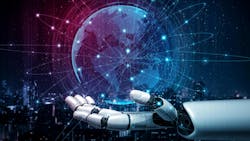Webinar rewind: 'Next Year’s AI' and more 2025 industrial technology insights
To view this program, register or use your prior credentials and start watching.
At Smart Industry, we’ve covered AI a lot already this year—to the point where we warned manufacturing technology people of how to avoid the AI hype-to-disillusionment cycle. That usually happens when a technology isn’t quite meeting its promise, and AI certainly hasn’t fallen into that category. Not yet, and we don’t believe it will in 2025, either.
Webinar rewind: Tons of tips from three experts on ‘Being Digital’
In fact, enthusiasm is still sky high for that technology and use cases are growing, as we’ll also reveal in our upcoming State of Initiative Report for 2024. In another one of our recent stories we reported on another external survey that saw AI moving past the ‘hype’ and speeding toward maturity—or so said the 1,400 IT people worldwide asked in the poll.
Webinar rewind: Getting the ‘Ts’ to get along
In this webinar, Alan Raveling, senior Technologist at Sioux Center, Iowa-based Interstates, a certified member of the Control System Integrators Association (CSIA), helps us explore AI use cases at his company and elsewhere in manufacturing and helps us look ahead to the technology’s evolution in 2025—with a sprinkling of speculation about other tech such as machine control and predictive maintenance.
The discussion with him turned out every bit as fascinating as we hoped. Please register if you haven’t already and watch!
Below is a synopsis of this Smart Industry program:
Scott Achelpohl: What AI “use cases” has Interstates identified or implemented and how might your work with the technology “mature” into the new year?
Alan Raveling:
- Code generation: Interstates has an internal charge to “automate the mundane” and there are certain aspects of programming which can lend themselves to automation. This is not to say we can go from AI-generated material straight to start-up, but we are expecting to realize significant time savings while enabling our personnel to focus on higher-level tasks and efforts.
Episode 4 of (R)Evolutionizing Manufacturing: The Art of the Possible and The Art of the Practical
- Idea generation: It’s much easier to iterate and revise existing materials than to come up with items when staring at a blank cursor. When we need a list of ideas, a starting prompt for some writing, or other items which would benefit from an initial flood of ideas, we give some prompts to our AI tools and see what pops out. Not everything is utilized, and that’s OK, but we view it as another team member in brainstorming sessions.
- Consulting/simulation: I’ve already presented on utilizing AI to assist in cybersecurity tabletop exercises and internally we have utilized AI to act as a means of training personnel on how to work support requests or troubleshoot client issues. Creating customized GPTs can really help to facilitate human-to-human interaction and is a great way to augment coordinated activities by providing new scenarios, a unique mixture of conditions, or even training individuals to deal with faulty or incorrect information.
See also: Survey shows ‘fear of missing out’ drives most AI adoptions
- Correlation/causation: Looking forward, we are beginning to analyze AI packages that should help to better identify correlations, causations, and dependent/dependent variables in process control systems. When a client wants to understand where the bottlenecks exist, it isn’t always as easy as finding the smallest tube and pointing to it. The ability to articulate the differences between as-designed, as-built, and as-operated, from both a theoretical and realistic perspective is a great way to drive conversation on where to prioritize resources to maximize output.
- Generative design: AI tools can certainly help design objects which meet specific design constraints but are much further away from designing an entire production line. There are many different layout tools, modeling plug-ins, and other items in use in CAD/CAM or other engineering packages which leverage AI to great effect. Coupled with 3D modeling, augmented reality, or 3D printing and mocking up items and then taking them to finished work pieces has never been easier.
About the Author
Scott Achelpohl
Head of Content
I've come to Smart Industry after stints in business-to-business journalism covering U.S. trucking and transportation for FleetOwner, a sister website and magazine of SI’s at Endeavor Business Media, and branches of the U.S. military for Navy League of the United States. I'm a graduate of the University of Kansas and the William Allen White School of Journalism with many years of media experience inside and outside B2B journalism. I'm a wordsmith by nature, and I edit Smart Industry and report and write all kinds of news and interactive media on the digital transformation of manufacturing.

